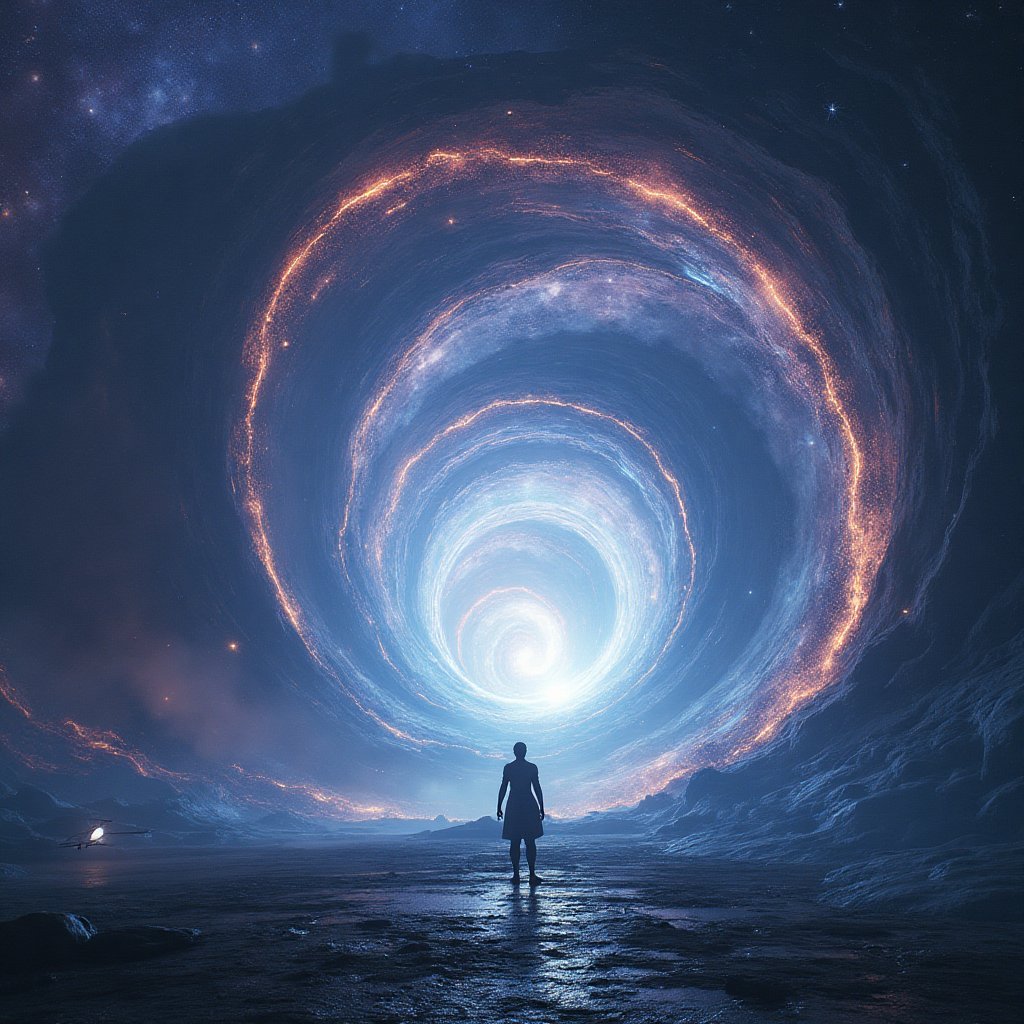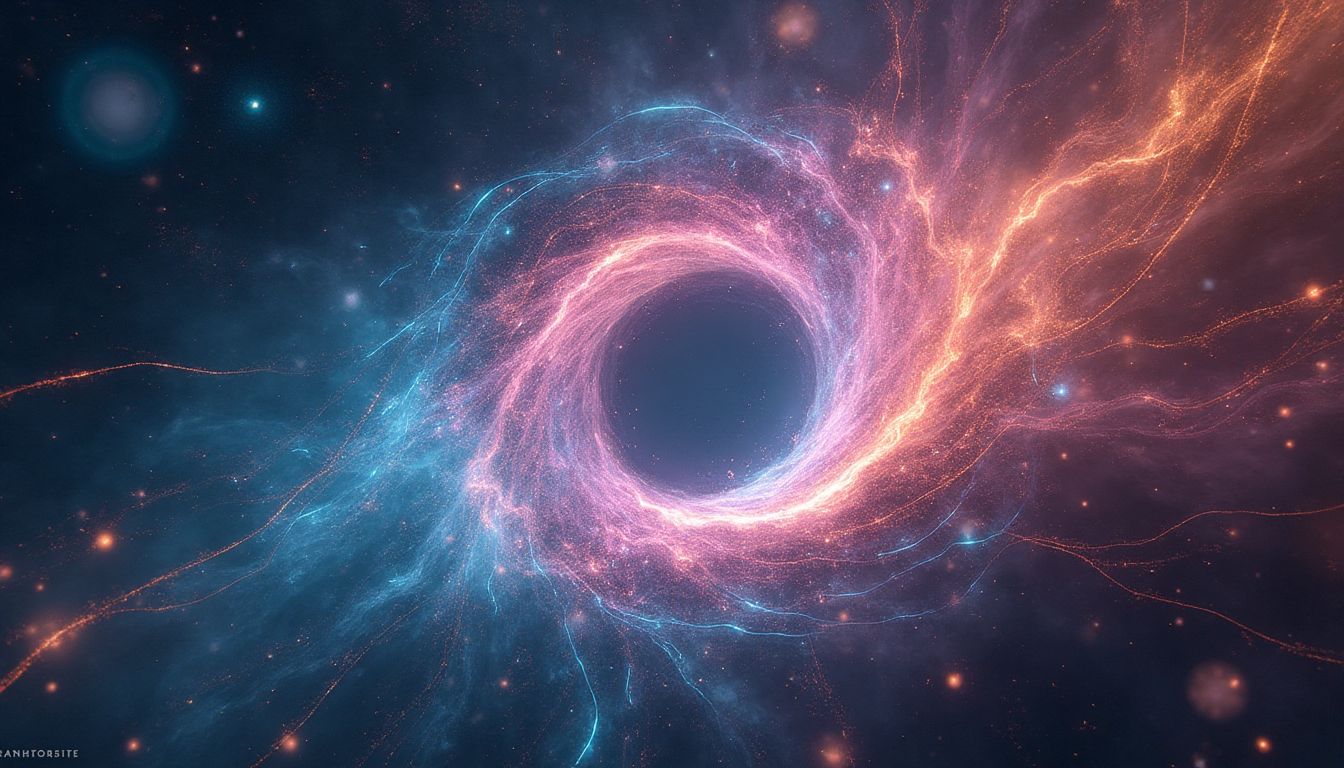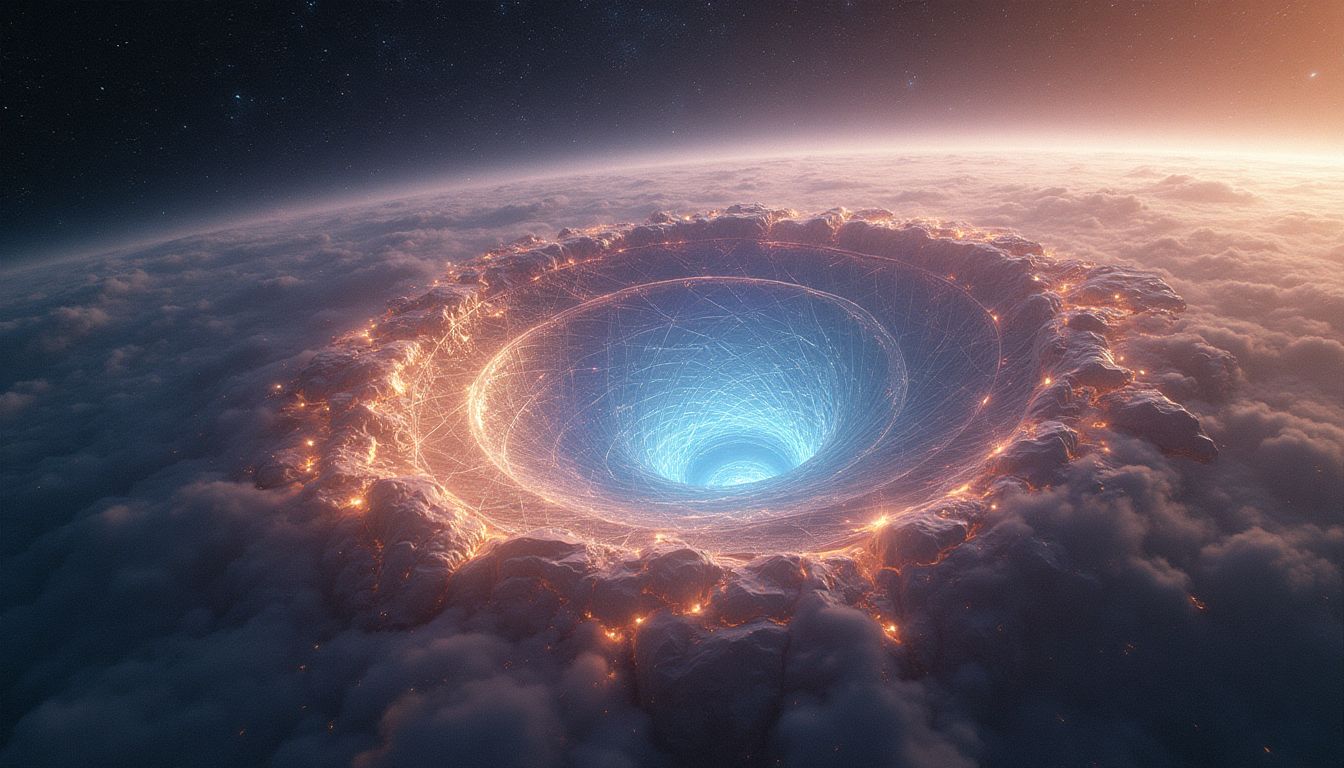Introduction: The Quantum Leap into Wormhole Exploration
"The very big, infinitely small, future, past—all is one." These words by Pablo Picasso, a name you wouldn’t typically hear in scientific circles, resonate more in the context of this mind-bending journey into wormholes. A whopping 13.8 billion years—how much of that time do we truly understand? As we slumber under a star-studded sky, sipping on trivia and theories, the universe stretches infinitely like a vast cosmic tapestry. But can artificial superintelligence—our shiny new AI toy—truly help us weave a path to the unknown? This isn't your everyday musing; it's the cusp of reality.
Now, what if I told you that intergalactic travel through wormholes, once stranded in the imaginative realms of science fiction, might now be within reach? The notion seems plucked from the pages of a fantastical story, yet in your next conversation, this topic won't be relegated to wistful daydreams but grounded in scientific discourse.
The prospect of wormhole travel is a bold frontier. Echoes of Einstein's theories provide a historical lens, while whispers of quantum physics fuel current speculation about stable wormhole passages. These are no mere daydreams—they could soon merge with our complex reality.
Meet some contemporary minds shaping these possibilities: Neil deGrasse Tyson steeps us in cosmic wonders, while L. Ron Hubbard took us on extraterrestrial narratives in another era. Add to the mix Brian Greene, who brings an eloquent spin to the enigma of the universe. Together, they form a medley of science and imagination, guiding curious travelers like us through realms previously uncharted.
But how precisely does this tie in with the formidable entity that is Artificial Superintelligence? Well, if we blend cosmic intrigue with ASI capabilities—the equation tilts towards the possibility of shaping realities once resigned to the untraversable domain of thought experiments. It's an era where dreams spin into designs and imaginations stretch beyond even those bright star-studded tapestries.
Theoretical Foundations of Wormholes
Historical Context and Development of Wormhole Theory
Let’s time travel back to the days when Albert Einstein, the quintessential physicist with an enviable hairdo, and his colleague Nathan Rosen were pondering over the mysteries of the universe. In 1935, these two brilliant minds formulated the idea of the “Einstein-Rosen bridge," which you might know as the charmingly mysterious concept we now call a wormhole. Their theory emerged from the depths of Einstein’s theory of relativity, which bent our understanding of space and time like a yoga instructor at a flexibility convention. This initial leap into wormhole theory was purely hypothetical but marked a cosmic watershed moment in theoretical physics.
As the years passed, curiosity-fueled physicists continued to pull on that wormhole thread. The concept evolved and expanded in the hands of other intellectual luminaries like Kip Thorne, the mastermind who consulted on the film Interstellar, where wormholes made a blockbuster appearance. Thorne, along with his scientist pals, explored how these cosmic shortcuts could be made traversable, basically trying to figure out how to turn a perilous wormhole into a safe cosmic highway.
Types of Wormholes: Traversable vs. Non-Traversable
Now, let’s chat about the two types of wormholes. Imagine them as two different kinds of tunnels through a mountain, but in space. We have the “non-traversable wormhole.” It sounds fancy, right? This is the kind of wormhole that’s basically a dead-end — a cosmic prank if you will. You can't actually travel through it to hop to another galaxy or even grab a galactic coffee.
Then there are the rock-star “traversable wormholes.” These are potential Einstein-Rosen bridges you can stroll through, galactic passport in hand, and pop out somewhere else in the universe. But here’s the catch: they require something extraordinary to stay open and stable. This is where exotic matter enters the picture. It’s like the fairy dust of physics: hypothetical stuff with negative energy density needed to keep these space tunnels from collapsing faster than a soufflé with a door slam.
The Role of Quantum Physics in Wormhole Stability
So, what is the secret sauce that might make a wormhole stable? Enter quantum physics — the universe’s version of a fantastic puzzle. Quantum mechanics adds layers to our wormhole understanding, thanks to floating ideas like entanglement and quantum foam.
Quantum entanglement, not to be mistaken for what happens when your headphones have a party in your pocket, is a process where particles become linked so that the state of one instantly influences the other, no matter the distance. Scientists ponder if we can harness this phenomenon to communicate between universal ZIP codes via wormholes, opening a galaxy of possibilities for instantaneous communication.
And then there’s quantum foam, which isn’t your morning cappuccino but the frothy, ever-changing layout of spacetime on the tiniest scales. Some physicists speculate that maybe, just maybe, these microscopic wormholes in the quantum foam could connect with our larger wormhole ambitions, providing stability from the atomic scale up.
Each nugget of knowledge builds on the other, connecting dots across decades, disciplines, and the universe itself. As innovative tech like Artificial Superintelligence (ASI) steps up, who knows how much deeper we’ll delve into these rabbit holes of spacetime. These ideas may have echoes of science fiction, but they increasingly resonate with the beat of future science fact.
Advances in ASI and Their Relevance to Wormhole Travel
The Current State of AI and ASI Technology
Imagine asking your computer buddy, "What's the weather today?" and it answers with the precision of a meteorologist. Artificial Superintelligence (ASI) is just that—our future computer buddy but on steroids. Where Artificial Intelligence (AI) has mastered chess and household chores, ASI promises to tackle the mind-bending realms of cosmic journeys. As we dive into the current landscape of AI and ASI technologies, think of it as unraveling a complex puzzle. AI today is built on machine learning and neural networks, acting like the brain of a child trying to understand the world. ASI, however, elevates this to Einstein-level smarts, potentially aiding scientists in figuring out how to travel across galaxies as simply as catching a bus.
Neural networks, the building blocks of AI, have inspired machines like AlphaGo to dethrone reigning human {game} champions. These systems mimic the human brain, processing information and learning patterns. The ASI potential is in its ability to simulate complex environments and predict outcomes, much like a cosmic oracle. With machine learning, it can analyze data at astronomical scales, refining theories and providing scientists with tools to envision new possibilities, like stable wormholes to distant galaxies. With great power comes great responsibility, and the same applies to Will Smith too in 'I, Robot'—AI technologies must be guided and monitored cautiously, lest they learn to order pizza every five minutes.
Machine Learning Algorithms in Theoretical Physics
When your rocket science becomes literal rocket science, machine learning is your co-pilot. Theoretical physics is the playground of gravity, quantum, and time—all swirling together in complicated dances. Enter ASI, the cosmic choreographer. With its machine learning algorithms, it can untangle the intricate science stuff like it's solving a Rubik's Cube blindfolded. But how do these algorithms work, you ask? By spotting patterns in data and making educated guesses. It’s like how a detective deciphers clues to solve a mystery. In physics, this leads to predictive modeling, offering a window into what might happen if we play with space and time.
AI-powered simulations can recreate conditions thought only to exist in imagination—and maybe on Tatooine. For wormholes, ASI machines can simulate how these space passages behave, revealing insights only previously seen in sci-fi novels. By constantly analyzing escalating mountains of data, ASI helps scientists tweak theories, ask "What if?" and demand "Why not?" Thus, amidst the dance of equations and cosmic exploration, ASI proves invaluable in bridging theory with reality and perhaps transforming Star Wars-esque dreams into tomorrow's adventures.
Safety Protocols and Ethics in ASI-led Research
Consider ASI technology to be a toddler learning to walk—curious, adventurous, but prone to spilling milk (or singularities to engulf our solar system). With such vast potential, safeguards are crucial. Safety in ASI research is akin to a well-secured lab, ensuring no accidental teleportation disasters occur. Imagine a reliable, automated fire extinguisher system built into the foundation of research development, preventing the possibility of tech turning against us autonomously, like a mischievous robot in Westworld.
Ethical considerations are the moral compass guiding the starship of ASI research. Like Spock from Star Trek, ethics help navigate potential asteroid fields of moral dilemmas. Should we trust ASI to make life-altering decisions? Can it truly appreciate the complexities of human existence or merely process them? These questions highlight our need for checks and balances, ensuring ASI serves as a responsible pioneer, not a rogue element. Safety protocols and ethics function as the seatbelt in wormhole travel—protecting us from unforeseen hiccups in our astro-adventures.
Engineering Challenges of Wormhole Creation
The Need for Exotic Matter: Theoretical and Practical Considerations
Creating a wormhole isn't as simple as conjuring a magic portal. One of the most critical elements in this cosmic cocktail is exotic matter. An ingredient straight out of a sci-fi recipe book, exotic matter has negative energy density, which is just a fancy way of saying it holds the keys to stabilizing wormholes. To keep these intergalactic highways open, we'll need copious amounts of it.
Theoretical physicists, like Kip Thorne, have hypothesized about exotic matter for decades. It's akin to the unicorn of physics, theoretically possible, but nowhere near being discovered at your friendly neighborhood science lab.
Let's not forget the challenge of sourcing this elusive matter. Existing technology doesn't even sniff it. That's where the creativity of science fiction becomes endearingly optimistic. We're talking 'hunt for squiggly, slippery eel in the vast ocean' level difficult. Science suggests that perhaps the quantum fields around tiny black holes could hold the answer. It's like searching for snowflakes in a desert but that's what makes this quest exhilarating.
Energy Requirements and Feasibility Studies
Next up in your wormhole starter pack is energy. Not your regular cup of Joe energy, but an astronomical amount that makes nuclear reactors look like AA batteries. Creating a stable wormhole would require energy on a scale that borders on the absurd.
Feasibility studies provide us with rough estimates. Imagine harnessing 100% of the sun's energy output for an entire year—yes, it's fantastically exorbitant. But researchers at CERN and other leading research institutes are trying to crunch these humongous numbers down to a more bite-sized reality.
Now, before you throw in the towel and think wormhole creation is a pipe dream, let's consider alternatives. Renewable technology advancements, like fusion energy and antimatter, show promise. These potentially habitable energy sources could power future wormholes, reducing our energy bills from the cosmic to the merely astronomical.
Engineering Paradigms for Creating Wormholes
Building a stable wormhole isn't going to be like assembling a model airplane. Picture this: you get a colossal cosmic jigsaw puzzle with forever-changing pieces. Now, assemble it.
Engineering paradigms need to evolve dramatically to accommodate wormhole construction. Think about it as going from wooden toy blocks to a 3D printer making skyscrapers. One promising approach is to use rotating black holes, also known as Kerr black holes, as frameworks. They have stable regions where, theoretically, a wormhole could be built.
For this to happen, scientists propose a slew of mind-bending methodologies, such as manipulating gravitational waves and harnessing quantum tunneling. Imagining and sketching such plans are a full expression of human ingenuity and curiosity, much like how scientists at NASA plan missions to Mars.
And so, the race is on. It's not just about applying known science but dreaming bigger. If the engineers of the future can solve these jigsaw threads, we'll go from theory to traversing galaxies.
In conclusion, the art of making a wormhole remains shrouded in complexity and enigma. Yet, it's this very tapestry of puzzles that makes the journey to create it so thrilling and full of wonder. A little sprinkle of imagination, grounded in solid science, can open portals to new worlds—not just in space, but in the way we think about technology itself.
Intergalactic Navigation and Its Implications
The Physics of Navigating a Wormhole
Navigating a wormhole might sound like something out of a NASA sci-fi movie, but it has real science behind it. Let's break it down. Think of a wormhole as a tunnel. One end enters our universe. The other end? Who knows? It could open up light-years away, in an entirely different galaxy.
But how do you steer through a cosmic shortcut? First, exiting accurately is vital. It's like aiming at a bullseye from space - if you miss, you can end up light-years away from your target. Scientists believe that mathematics is the key to precision. Researchers at Caltech and around the world use complex equations to predict where a wormhole might lead.
Beyond math, instruments play a big role too. You'd need incredibly advanced navigation tools to guide your trip through a wormhole. Imagine a GPS, but for space! These devices may use quantum entanglement—a phenomenon Einstein himself dubbed "spooky action at a distance"—to instantaneously share information about position and trajectory.
The Potential Discoveries of Intergalactic Travel
What could we find on the other side of a wormhole? Imagining is half the wonder! First off, water worlds with unique marine life might await. Imagine swimming alongside alien creatures that glitter with colors unseen on Earth.
Secondly, new energy sources could revolutionize our science. Let's say there's an element out there stronger than any we know. Tapping into it could change energy production forever. And who knows about cultural exchanges? Intergalactic travel might introduce us to civilizations as curious about us as we are about them.
Let's make a list to summarize some mind-blowing possibilities:
- New Habitable Planets: Finding new Earth-like worlds.
- Advanced Civilizations: Meeting intelligent extraterrestrial beings.
- Unknown Natural Phenomena: Starting-point for new scientific theories.
- Fresh Resources: Discovery of rare materials and energy forms.
While it's thrilling, scientists know it's uncertain and risky. Yet, this leap could redefine human experience, magnifying curiosity and discovery.
Societal Impacts of Intergalactic Travel
Now let's get personal. How could hopping through a wormhole transform life on our big blue planet? For one, it could reshape our world's economy. Intergalactic trade routes could lead to an exchange of goods unlike any marketplace we've known. But is trading alien tech wise?
The flip side is philosophical. What happens to the way humans think if we learn we're not alone among the stars? Theologians, philosophers, and everyday people alike might reshuffle their worldviews. If aliens are out there, how far does empathy reach?
There are potential social and ethical dilemmas too. Meeting new species impacts our global cultures and allegiances. How do we prepare for making contact, and what's next if we do?
Here's a thought experiment. What if, in your lifetime, traveling to another galaxy becomes as common as a transatlantic flight? Society would need laws for cosmic citizenship and inclusivity. People might need to rethink national identity altogether.
It's a big galaxy out there, and with the leap to intergalactic travel, Earth will never be the same. Opportunities and issues merge in this new era of exploration—not much different than when explorers discovered new lands on Earth. But these lands are among the stars.
Adventurers through wormholes will wear new titles: explorers, traders, citizens of the universe. They pilot not just spaceships, but the flight of human potential. Are you ready for an intergalactic future?
Real-world Application and Future Prospects
Current Research and Experimental Initiatives
In the world of scientific research, one of the most ambitious projects underway is the pursuit of stable wormhole travel. Scientists from around the globe are pooling their intellect and technology to unravel these hypothetical shortcuts through spacetime.
Current Initiatives Include:
- CERN Collaboration: Known for exploiting Large Hadron Collider technologies, CERN is focused on miniaturizing these massive devices to study energy scales necessary for wormhole persistence.
- NASA Quantum Initiative: NASA’s Quantum program is peeking into quantum entanglement to understand the forces that stabilize wormholes.
- Chinese Academy of Sciences: Unpacking the possibilities of exotic matter through cutting-edge detection devices and prediction algorithms.
Institutions like the Santa Fe Institute are creating interdisciplinary forums drawing theoretical physicists and AI specialists to push the boundaries of current wormhole theory. These collaborations are a testament to the growing recognition and potential of wormholes paving pathways between galaxies.
Incentives for Investment in Wormhole Technology
Bridging theoretical possibilities to practical applications, governments, and corporations are eyeing the cosmic pie’s potential rewards. The risks are substantial, but so are the potential incentives.
Here’s why investing in wormhole technology could be a stellar move:
- Educational Advances: With humanity’s thirst for knowledge on the rise, funding AI specialization programs, and physics research fuels growth in knowledge sectors.
- Economic Opportunities: If stable wormholes become a reality, the prospects for intergalactic trade and resource mining could equate to economic success of cosmic proportions.
- Technological Growth: As we deconstruct science fiction elements into science fact, spin-off technologies lead to an upward trajectory in computational power, bioengineering, and energy harnessing.
The progress in wormhole technology could mirror the industrial revolution’s impact but on an intergalactic level.
The Future of Humanity Among the Stars
At the heart of exploring wormhole travel lies humanity's leap into intergalactic space exploration. The stars are no longer mere points of light; they are next-door neighbors to explore and understand.
Wormholes could act as the cosmic bridges we need:
- Settlement: Planets that are reachable through traversable wormholes might become our new homes.
- Diplomacy: Potential interaction with extraterrestrial civilizations, embracing a universal ethos of cooperation, peace, and understanding.
- Cultural Enrichment: Engaging with diverse life forms and expanding the breadth of human cultural, artistic, and philosophical horizons.
The gift of moving beyond our current terrestrial limitations would emphasize mutual understanding and unity. Imagine a united Earth embarking on interstellar journeys together.
As we stand on the brink of these possibilities, ethical questions loom. What balance strikes between discovery, settlement, and existing cosmic ecosystems? Should we proceed without consideration for the autonomy of potential new civilizations?
These themes consistently emerge as dialogues among social scientists and astro-ethicists grow richer. Humanity as an intergalactic species presents both challenges and opportunities for harmonious coexistence in the vast, unfolding universe.
ASI Solutions
As we step into the realm of artificial superintelligence (ASI) and its potential role in creating stable wormholes, we find ourselves at the intersection of theoretical physics and technological creativity. Imagine a future where ASI doesn’t just assist us but actively drives the exploration of outer space. We can envision a world where intricate simulations and predictive algorithms challenge our existing theories about wormholes and even propose new mathematical frameworks that hadn't occurred to our best physicists. This chapter delves deeper into how ASI can tackle the multi-faceted challenges of wormhole creation, detailing the methodologies and innovations necessary for groundbreaking discoveries.
Firstly, let’s discuss advanced simulations. The first step ASI could take would be to create a series of oscillating simulations that mimic the conditions necessary for stabilizing a wormhole. By processing vast amounts of data related to quantum mechanics, relativistic physics, and theoretical models, ASI can simulate scenarios that test the limits of wormhole behaviors under various conditions. For instance, it might analyze the effects of differing density and velocities of exotic matter, running through trillions of potential configurations in milliseconds. This is where ASI would shine, identifying “sweet spots” where wormholes could potentially be stable or at least stabilizable.
Next, we would have predictive algorithms. By utilizing historical data, updated scientific literature, and collaboration with research institutions, ASI would estimate the feasibility of various mathematical theorems. Using technologies such as IBM’s Watson Studio and other cloud-based machine learning platforms, we could see ASI continually refining and revising its predictions as new experimental data becomes available. In a sense, ASI could act as a supercharged scientist, quickly vetting hypotheses that we mere mortals aim to test. Imagine a neural network-solving problems no human has even considered—creating an elegant bridge between computer science and physics.
Furthermore, ASI could initiate a comprehensive accessibility approach. Any research findings about wormholes would be made publicly accessible, allowing worldwide collaboration and participation from academics and enthusiasts alike. Crowdsourcing theories around wormholes could lead to an explosion of creativity that even ASI wouldn’t anticipate. Participating in open forums, think tanks, or academic groups like the American Institute of Physics allows diverse voices to contribute to this monumental scientific pursuit.
We would also implement protocols ensuring safety and ethical considerations surrounding ASI involvement. It’s crucial to remember that with great power comes great responsibility. Ensuring transparency in ASI’s operations would include integrating safety nets and failsafes. An independent committee of experts could regularly assess and validate ASI’s suggestions and implementations, much like a review board in clinical research. Consumers would also have the right to question and demand explanations for ASI’s decisions, nurturing a culture of accountability among scientific communities.
Finally, education plays a pivotal role in integrating ASI as an ally in the scientific community. Initiatives could reach into schools and universities globally, building the next generation of thinkers well-versed in both physics and AI. Launching programs that merge AI education with physics can ignite interest and create a breed of hybrid experts who are comfortable navigating abstract scientific concepts while understanding the implications of AI technology.
With these objectives, we now move on to a structured roadmap to foster the technological landscapes necessary for ASI to create wormholes. Borrowing from the meticulous planning that guided projects like the Manhattan Project, this strategy maps out the tasks and milestones from Day 1 to Year 2.
Actions Schedule/Roadmap (Day 1 to Year 2)
This roadmap outlines a potential pathway that any institution, organization, or government could follow. It's designed to be flexible enough to adapt to changing scenarios while providing a solid foundation for scientific exploration.
Day 1: Initial Team Assembly
The first step is to gather an elite team consisting of physicists, computer scientists, engineers, and ethicists. The aim is to create a balanced group capable of tackling a wide array of problems. Key players could include leading figures from top institutions, like California Institute of Technology (Caltech) and Stanford University. Their experience and prestige would pave the way for collaboration with other teams.
Day 2: Setting Up Interdisciplinary Collaboration Frameworks
Develop communication channels and frameworks for interdisciplinary collaboration among various stakeholders. An online platform can facilitate idea sharing, enabling real-time feedback and collective brainstorming. Collaborators might include NASA, international space agencies, and even private space exploration initiatives like SpaceX.
Month 1: Establishing Grant Proposals and Funding Sources
Craft grant proposals aimed at scientific funding bodies and private investors interested in cutting-edge technology. Crowdfunding campaigns about wormhole research could also be launched to gauge public interest and secure non-traditional investment sources.
Month 5: Initial Feasibility Studies
Conduct feasibility studies which evaluate the types of exotic matter required for wormhole stability. Collaborations with material scientists can delve into various available materials, directing efforts toward breakthroughs in quantum energy states.
Month 8: Drops in Machine Learning Algorithms
Implement machine learning algorithms capable of scanning historical data on wormhole theory and updates in physics. Collaborate with agencies experienced in AI technology, such as OpenAI, to develop advanced predictive modeling for wormhole research.
Year 1 - Month 1: Community Engagement Programs
Launch community engagement programs focused on educating the public about wormholes, ASI, and their potential applications. Involve educational institutions, especially targeting students in STEM (science, technology, engineering, and mathematics) fields to cultivate the next generation of thinkers and doers.
Year 1 - Month 6: Data Analysis and Pattern Recognition
Mid-year review of ongoing research, focusing on data collected from simulations and community feedback. Pattern recognition will inform research direction and new avenues of inquiry.
Year 2 - Month 1: Prototype Development
Begin working toward prototype development based on insights derived from simulations and pattern recognition. Collaborate with organizations such as Massachusetts Institute of Technology for engineering skills and manufacturing capabilities.
Year 2 - Month 3: Internal Testing
Carry out rigorous internal testing on developed prototypes in controlled environments to gauge effectiveness, emphasizing safety protocols and ethical guidelines. Design testing environments that simulate bizarre and challenging conditions akin to those expected within a wormhole.
Year 2 - Month 6: Final Review and Publication
Consolidate the results and prepare for a public presentation of findings. Work toward drafting papers to be published in prominent scientific journals. Consider sponsoring symposiums in collaboration with institutions such as the American Physical Society to engage other professionals in the field.
Year 2 - Month 12: Preparing for the Next Phase
As Year 2 concludes, conduct a comprehensive assessment of all findings and progress made. Strategize on next steps, including expanding the research team, seeking new partners, and investigating advanced technologies available to tackle the next wave of challenges in wormhole exploration.
With this well-aligned roadmap, we can envision a collaborative spirit that combines cutting-edge technology and human ingenuity. By harnessing ASI and the collective minds of industry and academia, we inch closer to reality—a day when wormholes might bridge the vast and intimidating void of intergalactic distances, making our dreams of exploration tangible.
Conclusion: The Future is Within Our Grasp
As we stand on the precipice of space exploration, the tantalizing prospect of intergalactic travel through wormholes is no longer confined to the realm of science fiction. With the rapid advancements in Artificial Superintelligence (ASI), we are beginning to unlock the mysteries of the universe at an unprecedented pace. Each new discovery related to wormholes not only expands our understanding of the cosmos but also ignites our imagination about the boundless possibilities that lie beyond the stars.
Imagine traversing vast distances in mere moments, experiencing alien worlds brimming with new forms of life and untapped resources. This isn't a far-off fantasy; it's becoming a reality. The works of legendary physicists such as Albert Einstein and Nathan Rosen have laid the groundwork for the theories that could one day guide humanity through wormholes. Their legacy inspires the current generation of scientists who continue to decode the language of spacetime.
However, venturing into the unknown brings with it immense responsibility. The ethical implications of wormhole travel cannot be overlooked. We must tread carefully, ensuring that our explorations do not lead to exploitative or detrimental outcomes for other civilizations we may encounter. The potential for discovery is staggering, but so too is the potential for harm. It is imperative that we develop stringent ethical frameworks as informed by entities like the Association for Computing Machinery (ACM) that prioritize safety, respect, and cooperation in intergalactic ventures.
As we look toward the horizon of ASI-led research, the road ahead is filled with challenges and uncertainties. Yet, it is our ambition and quest for knowledge that propel us forward. The engineering problems presented by wormhole creation may seem insurmountable now, but innovative minds, equipped with ASI, are diligently working to overcome these hurdles. The journey from theoretical exploration to practical application will require collaboration among physicists, engineers, and ethical theorists alike.
In conclusion, the dream of intergalactic travel, once relegated to the pages of novels and the frames of films, is swiftly turning into a mission. With the right investments, cooperative spirit, and ethical considerations, the universe’s wonders await us. As we push the boundaries of science and technology, let us also push the boundaries of our responsibility toward one another and the infinite cosmos. Together, we stand on the brink of becoming an intergalactic species, and the adventure has just begun.
FAQ
1. What is a wormhole?
A wormhole is like a shortcut through space and time. Imagine two points in the universe are far apart, like Los Angeles and New York. A wormhole can connect those points directly, allowing you to travel from one city to the other instantly, instead of taking the long route through regular space. The concept was first mentioned by physicists Albert Einstein and Nathan Rosen in the 1930s.
2. How do wormholes work?
Wormholes are based on Einstein's theory of relativity. They suggest that spacetime can bend, similar to how a trampoline dips when someone stands on it. To create a wormhole, researchers think we would need something called “exotic matter,” which has strange properties. This exotic matter could keep the wormhole open, allowing things to travel through it.
3. What is Artificial Superintelligence (ASI)?
Artificial Superintelligence is a type of AI that surpasses human intelligence in many ways. It can solve problems, make decisions, and even create new theories faster than we can. ASI is crucial for intergalactic travel because it might help us understand and stabilize the physics behind wormholes. For more about AI, check out MIT Technology Review on AI.
4. Can we create a wormhole with current technology?
Right now, we don’t have the technology to create a wormhole. We would need significant advancements in physics, engineering, and materials science. Scientists are exploring ideas, but making a practical wormhole is still in the realm of science fiction.
5. What are the dangers of wormhole travel?
Traveling through a wormhole may not be as safe as stepping on a plane. Some potential dangers include:
- The instability of the wormhole itself, which could collapse while someone is inside.
- The possibility of ending up in a different time or place—what if you traveled back to when dinosaurs roamed?
- Exposure to unknown cosmic dangers or high levels of radiation.
6. How is ASI helping with wormhole exploration?
ASI could help by simulating wormholes on computers, analyzing massive amounts of data, and predicting outcomes. It can speed up research by helping scientists test theories quickly. An example is how ASI has been useful in fields like drug discovery. For more on searches driven by AI, check out Nature’s findings on AI.
7. What is "exotic matter" and why is it important?
Exotic matter is a type of matter that has negative energy density and negative mass. This is important because it could keep a wormhole stable and open. We currently do not know if exotic matter exists, but some scientists are looking for it. The idea has excited researchers for years, leading to more exploration in particle physics.
8. What could we discover by traveling through wormholes?
If we could travel through wormholes, we might learn about:
- New planets and stars that we’ve never seen before.
- Different types of life capable of existing in various environments.
- New scientific phenomena that could reshape our understanding of physics.
9. Can we navigate a wormhole safely?
Navigating a wormhole presents unique challenges. Imagine trying to drive through a tunnel without any road signs. Scientists are still trying to figure out how to ensure you end up where you want to go rather than in the middle of nowhere. Reliable technology and careful experimentation would be needed to make this possible.
10. How will intergalactic travel change society?
If intergalactic travel becomes possible, it could transform our world in many ways:
- Human philosophy might shift as we think about our place in a larger universe.
- The economy could grow with new industries focused on space exploration.
- We may encounter other intelligent beings, raising ethical questions about interactions and coexistence.
Feel free to leave your thoughts in the comments—what do you think would be the biggest benefit or challenge of traveling through wormholes? Let's spark a discussion!
Wait! There's more...check out our gripping short story that continues the journey: She didn't have time to scream
Disclaimer: This article may contain affiliate links. If you click on these links and make a purchase, we may receive a commission at no additional cost to you. Our recommendations and reviews are always independent and objective, aiming to provide you with the best information and resources.
Get Exclusive Stories, Photos, Art & Offers - Subscribe Today!





























Post Comment
You must be logged in to post a comment.